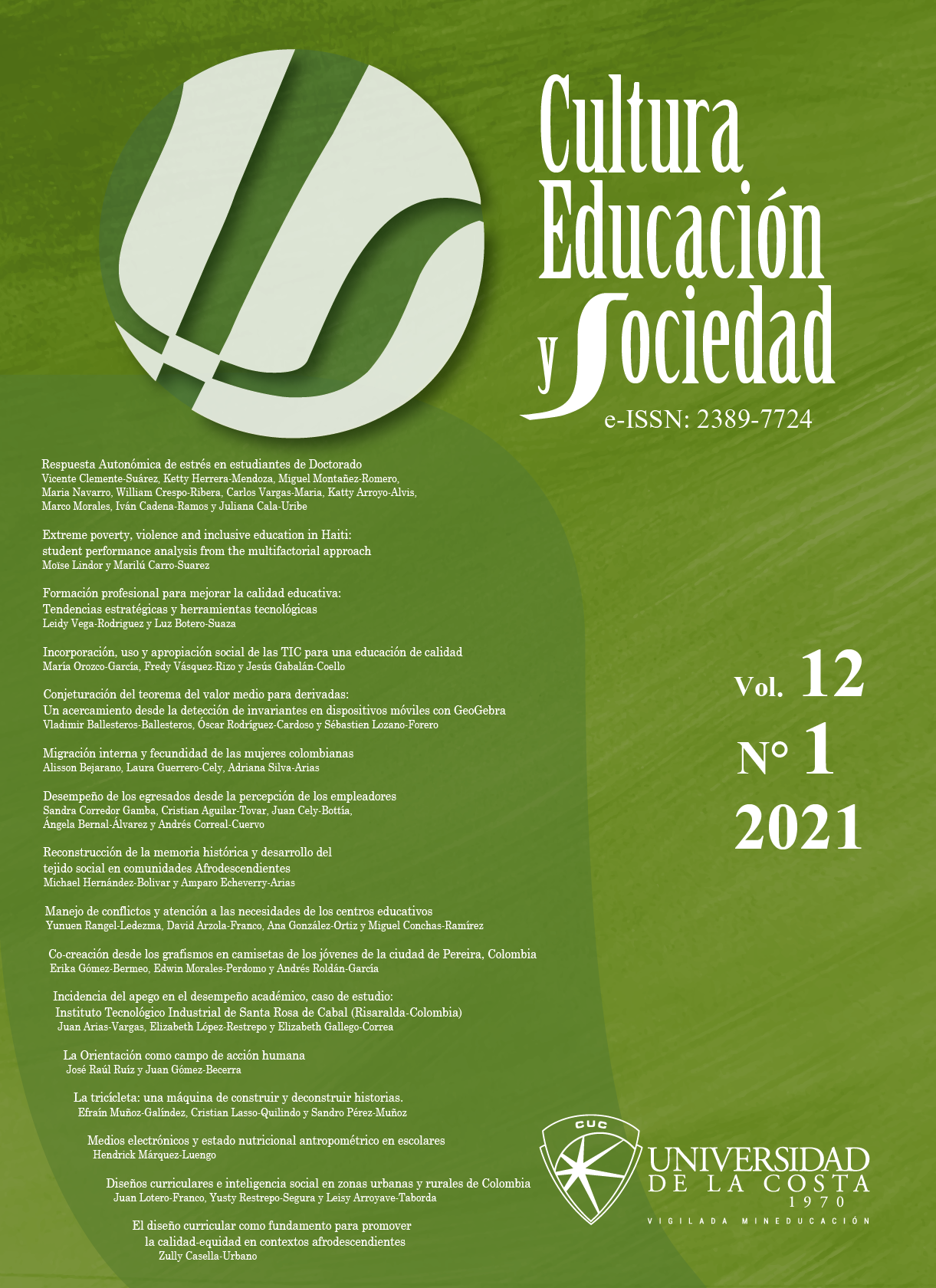Incidence of attachment in academic performance, case study: Industrial Technological Institute of the municipality of Santa Rosa de Cabal (Risaralda-Colombia)
DOI:
https://doi.org/10.17981/cultedusoc.12.1.2021.11Keywords:
Attachment, Academic performance, Psychology, Pedagogy, AdolescenceAbstract
The article presents the results of the investigation “incidence of the type of attachment in academic performance”. The objective of which was to analyze the incidence of the type of attachment on school performance in a group of 10th grade youth from the Santa Rosa de Cabal Industrial Technological Institute, in the municipality of Pereira (Risaralda, Colombia). 146 adolescents between 16 and 20 years old, from grade 10 participated. The research is quantitative with a non-experimental descriptive-explanatory transectional design. Instruments such as the Camir questionnaire that measures attachment representations and the record of partial and global grades for the IV academic period of 2019 were used. The results show that there is no relationship between the type of attachment and academic performance, which indicates that it is necessary to deepen, both theoretically and empirically, the relationship of these variables.Downloads
References
Balluerka, N., Lacasa, F., Gorostiaga, A., Muela, A. y Pierrehumbert, B. (2011). Versión reducida del cuestionario Camir (Camir-R) para la evaluación del apego. Psicothema, 23(3), 486–494. Disponible en https://psycnet.apa.org/record/2011-15648-022
Bautista, S. (2015). El maestro de ei como figura de apego: pautas de intervención. [Trabajo grado]. Univeridad de Salamanca, Zamora, España. Disponible en https://gredos.usal.es/handle/10366/130257?locale-attribute=fr
Bowlby, J. (1993). El Apego. Barcelona: Paidós.
Carrera, G. O. (2007). Apego y anorexia: manipulación de las experiencias tempranas en ratas y desempeño en el procedimiento experimental de anorexia basada en la actividad. [Tesis Docotral]. Universidad Santiago de Compostela, Santiago de Compostela, España. Disponible en http://hdl.handle.net/10347/2298
Collel, J. y Escudé, C. (1998). La educación emocional. Revista dels Mestres de la Garrotxa, 19(37), 8–10. Recuperado de http://www.xtec.cat/~jcollell/ZAP%20Trac.pdf
Durán, S., García, J., Parra, A., García, M. y Hernandez-Sánchez, I. (2018). Estrategias para disminuir el síndrome de Burnout en personal que labora en Instituciones de salud en Barranquilla. Cultura Educación y Sociedad, 9(1), 27–44. Disponible en https://revistascientificas.cuc.edu.co/culturaeducacionysociedad/article/view/1809
Fonagy, P. (2004). Attachment Theory and Psychoanalysis. Barcelona: SPAXS. S.A.
Gómez, A. S. (2006). Una estrategia para aumentar la retención de los estudiantes. [Estrategias para la retencion escolar]. Bogotá, D.C.: Ministerio de Educación Nacional Departamento Nacional de Planeación.
Guana, A. L. (2009). Relaciones entre apego, factores de personalidad y logro académico de las estudiantes de grado undécimo de un centro educativo femenino de la ciudad de Bogotá. [Trabajo de grado]. Centro de estudios avanzados en niñez y juventud Universidad de Manizales CINDE, Manizales, Colombia. Recuperado de http://ridum.umanizales.edu.co/xmlui/bitstream/handle/20.500.12746/1186/Guana_Vasquez_Andrea_Liliana_2009.pdf?sequence=1
Gutiérrez, H. & De la Vara, R. (2007). Análisis y Diseño de Experimentos. México, D.C.: McGraw-Hill Interamericana.
Hazan, C. & Shaver, P. (1994). Attachment as an organizational framework for research on close relationships. Psychological Inquiry, 5(1), 1–22. Available: http://apegosposibles.com/sites/default/files/hazanandshaver.pdf
Hofer, M. (1995). Hidden regulators: Implications for a new understanding of attachment, separation, and loss. Washington: Analytic Press.
Lafuente, M. J. (2000). Patrones de apego, pautas de interacción familiar y funcionamiento cognitivo. Revista de psicología general y aplicada, 53(1), 165–190. Disponible en https://dialnet.unirioja.es/servlet/articulo?codigo=2356868
Main, M. (1990). Methodologies and the concept of conditional strategies. Berkeley: Universidad de California.
Marrone, M. (2001). La Teoría del Apego. Un Enfoque Actual. Madrid: Psimática.
Musitú, M. J. (2001). La familia y la educación. Barcelona: Octaedro.
Pérez, M. P. (2015). Relacion entre percepción del vínculo afectivo y dificultades de aprendizaje a nivel de lectura. [Tesis de maestría en psicología]. Universidad Católica de Colombia, Bogotá, D.C., Colombia. Disponible en https://repository.ucatolica.edu.co/bitstream/10983/2220/1/V%C3%8DNCULO%20AFECTIVO%20Y%20DIFICULTADES%20DE%20APRENDIZAJE.pdf
República de Colombia. MEN. (2014). Sistema Nacional de indicadores educativos para los niveles de preescolar, básica y media en Colombia. Bogotá, D.C.: MEN. Disponible en https://www.mineducacion.gov.co/1759/articles-363305_recurso_1.pdf
República de Colombia. MEN. (2009). Fundamentos y orientaciones para la implementación del Decreto 1290 de 2009. [Online]. Recuperado de https://www.mineducacion.gov.co/1621/articles-213769_archivo_pdf_evaluacion.pdf
República de Colombia. MEN. (11 de febrero de 2002). Por el cual se dictan normas en materia de currículo, evaluación y promoción de los educandos y evaluación institucional. [Decreto 230]. DO: 44710. Recuperado de https://www.mineducacion.gov.co/1621/articles-103106_archivo_pdf.pdf
Rholes, S. & Simpson, J. (2004). Attachment theory. Basic concepts and contemporary questions. En, W. Rholes & J. Simpson (Eds.), Adult Attachment. Theory, Research and Clinical Implications (pp. 3–14). New York: The Guilford Press.
Ruhl, M. P. (2017). Relación entre apego con progenitores y pares, autoestima y rendimiento académico en adolescentes de 17 y 18 años. [Tesis de licenciatura]. Pontificia Universidad Católica de Argentina, Buenos Aires, Argentina. Disponible en https://repositorio.uca.edu.ar/handle/123456789/560
Ruíz, C. (2001). Factores familiares vinculados al bajo rendimiento. Revista complutense de educación, 12(1), 81–113. Disponible en https://revistas.ucm.es/index.php/RCED/article/view/RCED0101120081A
Sarmiento, G. A. (2006). Una estrategia para aumentar la retención de los estudiantes. Bogotá, D.C.: Ministerio de Educación Nacional y Departamento de Planeación. Recuperado de https://www.mineducacion.gov.co/1621/articles-122720_archivo_pdf.pdf
Shaver, P. & Mikulincer, M. (2002). Dialogue on adult attachment: diversity and integration. Attachment & Human Development, 4(2), 243–247. http://dx.doi.org/10.1080/14616730210157484
Published
How to Cite
Issue
Section
License
Copyright (c) 2020 CULTURA EDUCACIÓN Y SOCIEDAD

This work is licensed under a Creative Commons Attribution-NonCommercial-NoDerivatives 4.0 International License.
![]()
Creative Commons 2020 CULTURA EDUCACIÓN Y SOCIEDAD
This article is under international license Creative Commons Reconocimiento-NoComercial-SinObrasDerivadas 4.0.
The published articles are the sole responsibility of their authors and do not necessarily reflect the opinions of the editorial committee.
CULTURA EDUCACIÓN Y SOCIEDAD respects the moral rights of its authors, who assign to the editorial committee the patrimonial rights of the published material. In turn, the authors inform that this work is unpublished and has not been previously published.
All articles are under a:
Licencia Creative Commons Atribución-NoComercial-SinDerivadas 4.0 Internacional.
![]()


 English
English
 Español (España)
Español (España)




_12.53_.27_p_. m_._3.png)





_12.57_.35_p_. m_._3.png)
_12.50_.37_p_. m_._3.png)



